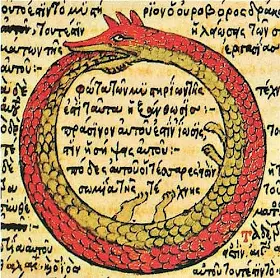Yesterday I had a decisive epiphany listening to an interview of Jay Weidner that I not only could spend the rest of my life researching Gnosticism and Hermeneutics but that I likely will. The motivation is the seemingly unending nature of the task, it's widespread connections with most of what I am interested in and most importantly its indiscriminate approach to exploration of all that is interesting and related to conciousness. It's probably a little late in the day to pick up an interest in such a topic but I've yet to hear an authority on the subject come close to boring. Here's a little sample of on the Ouroboros above and a podcast video of one of the pre-eminent experts in the world John Lash. My only regret is not discovering this fascinating subject earlier.
The Ouroboros is an ancient symbol depicting a serpent or dragon swallowing its own tail and forming a circle. It has been used to represent many things over the ages, but it most generally symbolizes ideas of cyclicality, unity, or infinity. The ouroboros has been important in religious and mythological symbolism, but has also been frequently used in alchemical illustrations. More recently, it has been interpreted by psychoanalysts, such as Carl Jung, as having an archetypical significance to the human psyche.
The Ouroboros is one of the oldest mystical symbols in the world. The serpent or dragon appears in Aztec, Norse, Middle East, and Native American mythologies, as well as in Ancient Greek, Gnostic, Christian, Hindu and West African cultures.
Plato described a self-eating, circular being as the first living thing in the universe—an immortal, perfectly constructed animal.

